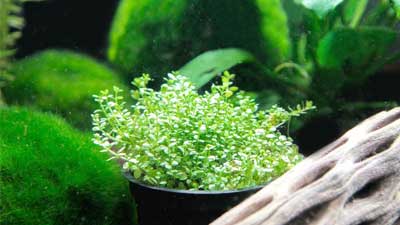Foreground Plants for Freshwater Tanks
Aquarium plants play a significant role in providing a suitable environment for aquatic organisms. Other than being a source of oxygen, aquatic plants also help in removing nitrates and chemical waste products from the tank while providing shelter for smaller fishes. In general, these plants contribute greatly to improve and maintain the quality of tank water, and making fishes less susceptible to diseases.
Aquarium plants are segregated into three categories – fore, mid and back ground, depending on their height and position in the tank. Foreground plants are usually placed at the front of the tank, and are favoured for their height and slow growth pace. These plants can add dimension to the tank without compromising the aesthetics of the other details. Similar to foreground plants, carpet plants are also very popular among hobbyists who want to create a viewing tank without spending too much effort. Like the name suggests, carpet plants tend to spread outward rather than upward, and can blanket over the bottom of the tank to create an aesthetic very similar to that of a carpet.
Some foreground plants suitable for new hobbyists include Java Moss, Dwarf Baby Tears and Dwarf Hairgrass.



Java Moss is definitely one of the more common aquarium plants in the Southeast Asia market as it is native to the region. This plant thrives in moist tropical climates and are usually seen growing on rocks, river banks and tree trunks. In domestic tanks, java moss is favoured for its low maintenance and high tolerance against a wide range of environmental conditions and diseases. Its hardy nature makes it a popular choice for freshwater aquarists who are just starting to venture into the world of aquascaping. Aesthetics aside, java moss is also a great choice for breeding tanks as it multi tasks as a source of food for breeding fish while serving as a shelter for eggs and fry.
Tip: For enhanced aesthetics, consider attaching the plant to driftwood, gravel, rocks or other tank decorations such that it wraps around the surface as it grows, giving the tank a rustic detail.
Dwarf Baby Tears (DBT) is usually seen growing in tanks with mostly acidic water (pH levels ranging from 5.0 to 7.5), and temperature between 70 and 84 degrees Fahrenheit. Unlike Java moss, DBT rely on their roots to absorb nutrients and is thus recommended to be planted in soil. DBT is helpful in preventing excess algae growth and makes for a suitable environment for spawning fish to lay eggs and shrimp tanks. This plant is most suitable for small to nano tanks due to the small size and bright lighting requirement. Larger tanks might see difficulty in growing DBT due to uneven lighting and water conditions.
Tip: For Dwarf Baby Tears to grow at the bottom of the tank, ensure that ample sunlight reaches the bottom of the tank, or the plants will grow towards the light and can potentially blanket over the other fully submerged plants.
Dwarf Hairgrass is a popular starter plant for new aquarists due to its hardiness and adaptability. Other than providing an aesthetically pleasing appearance, the plant helps to control nitrate levels, removes pollutants and acts as a shelter to bottom dwelling fish. Similar to DBT, this plant requires bright lighting conditions in order to increase growth rate. Despite the plant’s hardiness, it is recommended to look out for unhealthy clumps with brown discolourations. Healthy Dwarf Hairgrass should have bright green blades and be able to support its own weight. Their blades grow fast, so trimming might be more frequent than other aquatic plants.
Tip: Consider laying Dwarf Hairgrass throughout the bottom of the tank, but trim them such that they grow taller at the back of the tank and shorter at the front.

04/10/2020 @ 3:21 pm
Hi. I’m glad he found sunnyaqm.com website, I really like it,
the article is very useful and I shared it!
11/19/2020 @ 7:41 pm
Do you mind if I quote a few of your articles as long as I provide credit and sources back to your weblog? My blog is in the exact same area of interest as yours and my users would genuinely benefit from some of the information you provide here. Please let me know if this okay with you. Thank you!
12/07/2020 @ 11:32 am
Hi Dinkle,
Sure thing! Glad you like the article!
08/28/2021 @ 9:10 pm
You are my breathing in, I have few blogs and sometimes run out from to post .